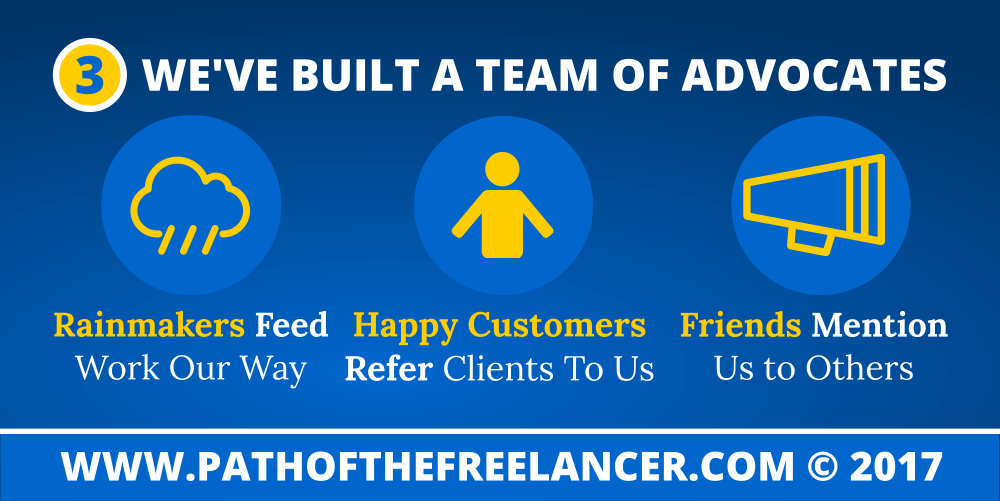
8 Steps For Empowering Your Fragmented & Unmotivated Sales Team
Small companies live and die by the success of their sales team. And when it’s failing, the owner is forced to dive in and help right the ship, or at least they feel that way.
But them simply diving into sales to do it themselves is only a short-term answer (if at all). The key is for them (or a sales leader) to stick around long enough to train and empower their team towards sustainable selling.
While a critical component of sales success is a visible, data-driven sales engine, the other just as important factor is a personalized plan and motivation for each individual salesperson and team.
Personally aligning your people with the organization’s objectives creates a system driven tension and accountability for pushing and pulling your people forward. No longer are you or management having to do this. Instead, it’s driven by the individual.
When I clearly understand what I want and how to get it I’m personally invested in moving the ball forward. When I also clearly see how my work is contributing to the organization’s intentional goals, my work and team success now act as additional driving forces to perform at the highest level.
The following steps are a walkthrough for you to travel down with each of your salespeople one-on-one. This roadmap will guide you through the essential ideas, questions, and actions to cultivate personal and relevant buy-in from your sales team. Here's an outline of the eight steps.
- Formalize Personal & Professional Intentions
- Create A Personal Income & Growth Plan With Each Sales Person
- Discover Fun & Meaningful Non-Financial Objectives
- Identify Their Preferred Selling Approach
- Discover How They Personalize Your Well Defined Offering To Match Their Identify & Approach
- Help Them Build A Team of Advocates
- Set A Relationship Cadence For Active Customers, & Transition Transaction Clients Into Ongoing Ones
- Monitor Activities & Prod For Sustainability

Step 1 - Formalize Personal & Professional Intentions
Motivation is broken into two tensions. Push and pull. You’re familiar with the stick (push) and carrot (carrot) terminology.
When the team is not doing what we hope and expect, our inclination is to push, to leverage the stick to make things happen.
And while that may be necessary, it’s truly a symptom of failing to anchor into these two tensions in a personally relevant way. If you're having to personally push and pull your sales team forward, you don't have a good sales system in place. A strong system and individually invested sales team will do the hard work for you.
What we want instead is the purpose (why?) and vision (where?). When we go deep with intentions, we establish a bedrock foundation for long-term commitment and motivation.
Here are several questions to root out the why and illuminate the where for your sales team members.
Helpful Purpose (Why?) Questions.
-
Why do you get up in the morning?
-
Why do you work?
-
Why are you in sales?
-
Why are you selling for this company?
-
Why are you selling these products?
-
Why do you want to sell to our customers?
-
Why will customers become raving fans telling everyone they know to use our company?
Helpful Vision (Where?) Questions
-
Personally, where do you want to be by years end? Five years? Ten?
-
Professionally, where do you want to be by year’s end? Five years? Ten?
-
Over the next few years, paint a picture of what your team looks like? The sales department? Sales Support? The organization as a whole?
-
Paint a picture of what an ongoing and growing client engagement looks like?
-
What does it look like for them when a customer is fully engaged with our company at every desired level? How does it affect them, their team, and their organization?
-
What does it look like when our raving fan customers are referring other people and organizations our way?
As you read these, many might have you excited while others are ones you need to answer for yourself!
Other questions make you nervous about asking your team. What if my question asking leads them not wanting to sell at all or work for our company?
That’s the point. We want people who are fully committed. If they’re going to leave as a result of questions, they’d eventually leave anyway. Let's accelerate the process.
As part of the hiring process, Zappos offers thousands of dollars to prospective employees at the last step to NOT take the job. They do this to root out the uncommitted and to more deeply anchor those who stay. If they wouldn’t leave for five grand, they probably won’t leave.
As you read these questions, you might also be concerned about the personal nature of some questions. You might be thinking, I don’t care why they do it, I just care about results! If that’s the case, this is likely a big reason your team is not motivated or performing. It’s also why you drag them because with them clearly knowing their motivations, they’ll drag you.
Knowing where the salesperson is on the map and where to they’re planning to go gives you the coordinates required to map out how you’ll help them get there. Our first step involves a personal income plan, which we dive into next.

Step 2 - Create A Personal Income & Growth Plan With Each Sales Person
One of the best things I did early on in Freelancing was clearly stating how much income I wanted to earn.
There was my survival level (red zone), what I needed to earn to take care of my basic financial obligations. There was my ideal target income level (green zone) to allow me to not only survive but to generously give and save for the future. And lastly, there was the area in between these two numbers (yellow zone).
Three and a half years in and I was earning my target income level. Our financial goals also include knocking out our student loans in the next year. From there, I want to build up a short-term reservoir, pay off our house, and build a long-term investment fund. In 20-30 years, we’ll want around $2 million in total (not adjusted for inflation).
This clarity is hugely helpful for me and would also be for your salespeople. Taking the time to map out their income so they can know if they're on track and what adjustments need to be made to succeed.
Internally motivated to accomplish these goals, they’ll be focused and passionate about how their efforts at your company will help them accomplish their goals. They’ll think of ways to accelerate their process while elevating the company.
Provide a clear financial path to their personal success and focus on removing the roadblocks that slow down or stop their efforts.
The key here is not stopping at creating a financial roadmap for the individual but discovering how their success directly drives the success of the business forward. And the incentives need to correlate in a close way. But, while money is important, non-financial objectives are just as vital to explore.
Step 3: Discover Fun & Meaningful Non-Financial Objectives (leadership training, traveling, writing a book, etc...)
Money matters, but once money no longer matters it’s motivational factor is limiting. Plus, people want meaning, and while contributing to the company’s success is a form of accomplishment, everyone has personal aspirations for themselves, family, and community.
Whether it’s traveling the world, writing a book, starting a nonprofit, building their own business, or simply growing as a leader within your organization people have something they want to cultivate.
The key here is to identify what personally motivates your team outside of work and money, and build stepping stones to encourage them forward on that path. When their company is helping them personally make a positive impact on the world, it provides an entirely different level of loyalty to your organization and significance in their life.
And what an incredible company you’ll have bringing to life the dreams and visions of your employees!
Step 4 - Identify Their Preferred Selling Approach (grill or crockpot)
When it comes to sales people there are two high-level approaches to pursuing new business.

The first is the outbound grill salesperson. This is someone who sees an opportunity and aggressively pursues it. Their activity will involve cold calling, emailing, networking, meeting people, and ultimately directly engaging for the purpose of landings the deal or maximizing the engagement.
The second sales approach is the inbound crockpot person. They’ll slowly and consistently share resources, follow up, and cultivate the relationship. These folks focus on providing value with the expectation that when the needs arise, they’ll become the go-to storefront for their products and services.
While great salespeople will operate proficient in both approaches, they’ll likely lean towards one of these two approaches. As their sales leader, knowing their primary approach allows you to empower them appropriately.
Step 5 - Discover How They Personalize Your Well Defined Offering To Match Their Identify & Approach
Like the boundaries of a basketball court, your sales engine will define the areas your sales team will operate within. While these constraints help guide them, they also provide the freedom to customize and personalize within the provided framework.
Addition to their preferred approach, you’ll also want to explore this person's strengths and personality. Know what they’re great at and leverage it to maximize their sales.
Using myself as an example and my top 5 talents as a reference, here are recommendations from Strengths Finder 2.0 to apply in this context.
-
Strategic - Present myself as a problem solver so when prospects and customers face challenges, I’m the one they come to for help. Set the expectation that my strategic strength is best utilized on the front end of the process.
-
Connectedness - Engage in industry groups as a way of growing myself and facilitating the connection between different people in a variety of businesses. Appreciating the interconnected web of business, I have the unique opportunity to facilitate these connections and add value to those I know.
-
Futuristic - With the ability to survey the horizon, my strength here allows me to communicate with others what to expect in the future. Learning my industry and applying these insights specifically gives me a unique opportunity with colleagues to inspire acting as a lighthouse as they navigate a similar terrain.
-
Context - I'm well equipped to learn from past failed projects. This also gives me the unique ability to teach case studies, act as a change agent, and to share meaningful insights.
-
Ideation - Experiment, research, and development leveraging visuals and metaphors, discovering ideas are ways I bring this talent into my sales role.
Knowing is importing, but the key here is mapping out these applications into daily, weekly, monthly, quarterly, and annual activities and habits.
Step 6 - Help Them Build A Team of Advocates
Evangelistic clients, rainmaking referral partners, and friends and family make up our team of advocates. Because, selling on our own is difficult, but having supplemental partnerships help bridge the gap when we can’t do it ourselves.

The first step to take in this situation is identifying all the people who have referred prospects our way. From there, we can group them into our categories, as their motivation for helping is different.
Raving clients will have had a terrific experience and want to tell others.
Rainmakers come across the need in their own journey and know you as a reliable source for delivering results. They want a reliable partner that will take care of the people they send your way.
And friends and family will send people your way when they come across need driven mostly because they value the relationship and want to help you succeed.
If we’ve been selling, we’ll have people in all these groups. Our mission at this point is discovering an action plan for cultivating these referral partners so we maximize the opportunities flowing our way. Our second objective is to grow the number of advocates.
Step 7 - Set A Relationship Cadence For Active Customers, & Transition Transaction Clients Into Ongoing Ones
Project-based customers are great to have, but to truly build a foundation we can grow a book of business requires an active relationship and ongoing opportunities to find and solve problems.

While I'm working with clients, I'm wearing my SOFI glasses. SOFI, Seeking Opportunities For Improvement. Capturing and planning what's next while working on what's now fosters proactivity and transforms project work into a stream of it.
In addition to a triggered approach, you could also run a quarterly audit where you provide recommendations, and this is a service you could charge for in addition to whatever you're selling.
Systemizing and incentivizing buyers to become an ongoing client is also a powerful option. Jon Taffer of Bar Rescue shares about an onboarding strategy he uses to transition restaurant patrons into regular eaters. This strategy is based on the insight that most people won't eat at a restaurant regularly until they've had three positive experiences.
So, he suggests using a red napkin for new guests, and treat them extra special during their first three experiences. At the end of each visit, provide a financial incentive to come back. The goal is to get them to move through those three visits as quickly as possible so they become an ongoing customer.
The key here is to engage proactively with your customers, and ideally, have a part of your sales system that makes this happen.
Step 8 - Monitor Activities & Prod For Sustainability
With all these accumulated steps, we’ll have more than a full plate of activities and actions to knock out on a regular basis. And, they'll be specifically geared towards effective action. Make sure to implement these actions into a tool like Habitica, Airtable, or Hubspot to ensure they don't disappear and are given the proper attention. These mechanisms will track our activities so we can maintain a high level of performance, and also assess and improve over time.
The key here as the sales team leader is not just monitoring the team's activity, but ensuring we don't abandon our team after things are going well. Either the business owner or sales leader needs to engage regularly with them to keep them on track and helping them overcome obstacles.
Hero Photo by Tobias Mrzyk on Unsplash





